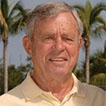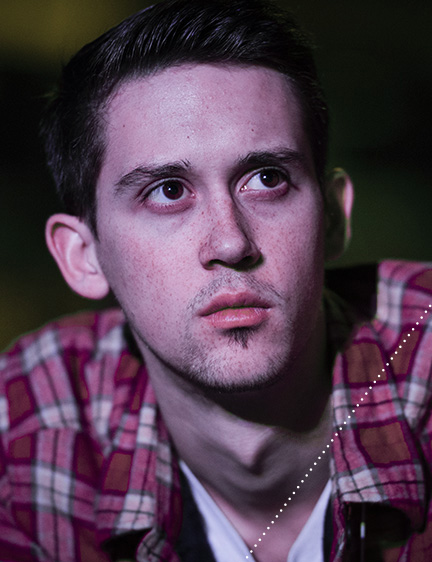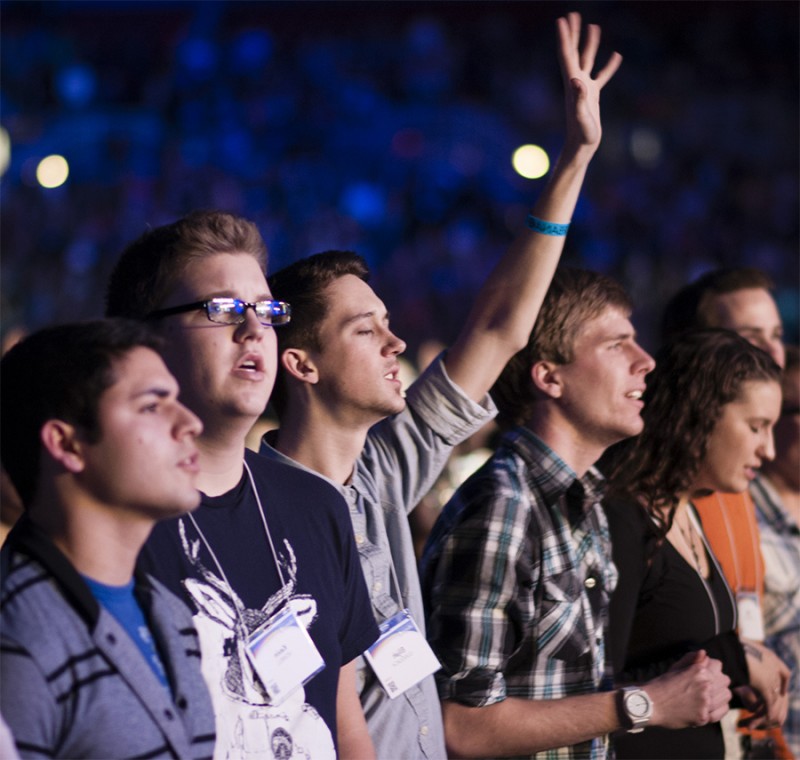An Interview with Dr. David Howard
Looking Back at 66 Years of Urbana

Background: I first met David Howard at the 1970 Urbana Student Missions Convention held in Champaign-Urbana, when he was serving as Assistant Director of the event and I was a senior in college. As alumni of the same college, we crossed paths numerous times over the next 40 years, most notably at the Lausanne Conference in Pattaya, Thailand 1980, Lausanne II in Manila 1989, and several World Evangelical Alliance Conferences. Since that time, David has held a series of increasingly strategic leadership roles in global missions. In the last decade I have had the privilege of seeing Dave several times a year in Ft. Myers, FL where he has retired and is remarried to Janet, after his first wife Phyllis died. I interviewed David at Urbana ‘12 in St. Louis, MO.
Steve: Where were you when you first heard about and attended
your first InterVarsity Student Missions Conference?
David: I heard about the convention as a freshman in college. I attended the first-ever InterVarsity Student Missions Conference as a 20-year old sophomore at Wheaton College. I attended with Jim Elliot, my best friend. We had met as freshmen on the wrestling team, and became close friends, both being involved in student missions. I had no idea then of how our lives would intertwine.
He was a very zealous missionary candidate, already committed to missions when he came to college. He was talking excitedly about missions and his desire to get to Ecuador as soon after graduation as he could get there. He was already focusing in
on Indian tribes—looking for the most difficult and dangerous place he could find. Once he discovered the Waodani (then called the “Aucas”—“The people”), the more he wanted to go into the Andean jungles to reach them.
Jim married my sister Elisabeth in 1953. In his biography written by Betty, The Shadow of the Almighty, she documents his early interest in missions even before he entered college.
At the first conference, I roomed with John Winston, an MK from Belgium. His experience as a missionary kid in Europe, and his experience in the Navy in WWII, made an impact on me.
From Toronto to Urbana. IV moved the student missions conference to a more central location in 1948—the spacious University of Illinois campus in Champaign-Urbana, IL, and I attended as a senior in college.
 Steve: Recap your cross-cultural involvement between those conferences and re-emerging at Urbana ’67.
Steve: Recap your cross-cultural involvement between those conferences and re-emerging at Urbana ’67.
David: When I finished college in 1949, I joined InterVarsity (IV), and traveled the 1950 school year as an appointed “missionary staff member,” challenging students to give their lives to missions. It was a significant experience for me in visiting over 120 schools in that year.
I married my college sweetheart, Phyllis Gibson, in 1950 and spent two years at the Wheaton Graduate School. I was also the assistant director of Urbana 1951. Little did I know how this triennial student convention would factor into my later life.
So as I completed my graduate work, and ministered with students on campus, Phyllis and I selected Latin American Mission (LAM) and moved to Costa Rica in 1953. At that time Colombia was a country closed to new missionaries. The country opened following a political revolution, and we entered in 1958.
Steve: Share with us a few of the most memorable and shaping moments that the Urbana Student Missions Convention had on your life as a missions leader.
David: Urbana ’70: I was the assistant director, after 15 years as a missionary in Colombia. Dr. John Alexander, president of IV, had invited me to assist Dr. Paul Little. Paul had joined IV as campus staff right out of college and had excelled in campus evangelism and training. He was named Director of Urbana ’70. He had quickly gained visibility from his best-selling book, How to Give Away Your Faith.
The end of the 60s was a tense time for IV. Kent State had just taken place, and a group of student radicals had shown up, held daily demonstrations, and printed a daily news sheet attacking the conference and our mission purposes. They wanted to commandeer the conference to focus on ending the war in Viet Nam, poverty, and other political issues.
Campus mood begins to shift. Only 8% of the 12,000 students signed the Decision Cards indicating any interest. By 1973, 28% of the students signed the cards. Missiologist Ralph D. Winter came to me after the conference, noting the change in attitude and interest. He was desperate to follow-up this fresh interest in world missions. By the summer of 1974 he had designed a two-week seminar for students, the Summer Institute of International Studies (SIIS), to explore the biblical basis, history, culture and strategy of missions. This was the precursor of the Perspectives course, which he produced and unveiled at Urbana 1979.
Computerized matching: Phill Butler came to us with a way for all participants to indicate their interests and passions and receive a computerized print-out of 5-10 agencies that had ministry openings in the area of their interests. This was the integration of the emerging information technology and mission mobilization.
Open up the schedule: Educator and consultant Dr. Ted Ward from Michigan State University suggested we replace afternoon plenary sessions with seminar-workshops and free time to browse in the Armory and visit the mission exhibitors and the IVPress bookstore. Eliminating the afternoon plenary session may have disappointed some at first, but greatly increased the interactivity between students and missionaries, seminar presenters, agency personnel and speakers. It was a schedule change that has lasted to this convention!
Urbana ’73: Two innovations stand out in my mind—even to this day. My former co-worker in Colombia,
- Gregorio Landero gave a full address through an interpreter. The students loved him, and showed us that the Spirit was speaking even through the interruptions of an interpreter.
- A woman gave a full plenary address—Elisabeth Elliot. I had resisted inviting my sister for years—for obvious reasons, but others over-ruled. She spoke powerfully from her own woundedness about the place of women in missions, and provided a three-dimensional model of what gifted and capable women could do in this generation in missions.
Urbana ’76 was a wonderful conference. There was a huge change in attitude of students, from the skepticism of the 60s, to the positive, even enthusiastic openness of the 70s students. They were much more excited and almost gung-ho about missions. We filled the university to capacity with 18,000 participants. Most significantly, there was a continued increase in the percentage of students indicating a willingness to consider missions as indicated on their Decision Cards. From only an 8% response in 1970, to 28% in 1973, student receptivity continued to grow!
-
We once again invited Dr. Billy Graham to return and speak to the students. He turned me down
flat at first, and was quite adamant about not speaking to students, thinking that the latest batch of students was not his prime audience. I persistently encouraged him to reconsider. When he walked on the platform the first time, the entire student audience of over 18,000 rose simultaneously to their feet, and giving him a thunderous and prolonged ovation for several minutes. That act convinced him he did have a message to this student generation. - Dr. Helen Roseveare was a powerful plenary speaker, who shared transparently about her missionary experience of capture, rape in Congo in the 60s. Her public vulnerability was probably a first for a student audience in the 70s, and paved the wave for subsequent messages by Becky Atallah from Cairo and another speaker from Afghanistan.
Urbana moves from Southern Illinois to St. Louis: Prior to Urbana 2006 IV made the decision to move from the U of IL campus in Champaign-Urbana, IL for several crucial reasons. Campus facilities were full to the max—dorms, cafeterias, and meeting rooms, etc. The spread of the university campus demanded a tremendous logistical effort to transport students to meals, to the Assembly Hall, the exhibitor space, as well as afternoon workshops. Each move consumed considerable time out of the conference schedule. The St. Louis Convention Center is a spacious hall for plenary sessions, and the adjacent hotels are much closer to the meeting venues than were the Urbana dorms, and the public transportation system is efficient in moving people around.
Steve: What are some biblical essentials at age 85 you have a concern for Urbana to sustain?
David: Missions is not just to another part of the world, but also to cross-cultural opportunities and needs
which are local. It must always be a both-and balance; never either-or. It must be Local and Global, or
Glocal missions.
There are some sectors of the world, like the South Sea Islands or Oceania, who have been contacted, and realize their responsibility to respond “From the Uttermost” to those areas that remain unreached. That highlights the vital importance of maintaining a laser focus on the remaining unreached peoples—those people groups that remain beyond the reach of God’s tender mercies. Since Ralph Winter’s catalytic address at Lausanne 1974, highlighting the necessity of recognizing the “task remaining” of making disciples among every unreached people of our world, we have seen the move from mere geography (nations), to a focus on unreached people groups. As we have learned from the worldwide Lausanne movement, it is the critical responsibility of church
and mission leaders to keep missions focused on the “main thing.”
There is a great danger in an overemphasis on such immediate needs as global poverty, human capture and rape or earthquake relief in Haiti, that we lose a big picture focus on the task remaining. Pressure groups
have arisen over the years that advocate for emphasis on their particular focus (e.g. French-speaking Canadians, Asian-Americans, left-handed artists in Paris, etc). But there remains a task to be completed—and that is to make disciples in every nation, people and language group. While particular pockets of need and specific audiences are critical to identify, we cannot lose our simultaneous focus on the larger biblical mandate to make disciples everywhere.
Urbana has struggled to resist the temptation to succumb to the myriad pressure groups that want that kind of public exposure. We cannot give up what Urbana has been for since 1946.
 Steve: Looking back, what would you estimate to be the kingdom impact of the Urbana Student Missions Convention over the last 66 years?
Steve: Looking back, what would you estimate to be the kingdom impact of the Urbana Student Missions Convention over the last 66 years?
David: The first impact I have seen is the countless individuals I have met—around the world—sometimes missionaries, sometimes nationals, who testify: “I want to tell you that it was at Urbana that God spoke to me, or called me, or turned my life around and I was given a vision for the world church and that is what I am doing.” That has been by far the most gratifying thing. I heard it again this week—how many people came up to me specifically to thank me for my role and to comment on the impact of a particular conference.
Second, though Urbana does not immediately deliver thousands of fresh candidates to mission agencies as we all might wish, the conference has had a significant ongoing impact on kingdom mobilization by doing what it does best—it provides an immensely popular, contemporary, and excellent venue for students and young people to hear from God in the context of a changing world. Urbana does not in one week “make” students into missionaries. But it has provided a “top of the funnel” experience for tens of thousands of students since 1946. For many it was their first-time exposure to what God was doing in the world. For others it provided Spirit-revealed inspiration to consider missions. For countless thousands over the years it provided a space in which students could meet, up-close-and-personal, veteran missionaries with up-to-the-minute accounts of specific locales in the world, where they could get their questions answered by world-class missions experts and specialists. For providing this venue, churches and mission agencies are incredibly grateful.
Third, the shift to a broader biblical emphasis on holistic mission—ministry in Word, Deed and Power—has provided a scriptural framework in which this generation can operate. A Word-only approach might have turned off each successive generation decades ago. In a vital way, Urbana has kept in step with what the Spirit has been saying to and doing in the global Lausanne Movement, as well as in the World Evangelical Alliance and the Majority World Mission Movement. IV has fought to maintain a biblical “balance” between either extreme—an emphasis on Word evangelism on one hand or on social engagement on the other. Instead, they have sought to keep the message biblically balanced and holistic—without losing a razor-sharp edge on reaching the unreached.
Fourth, it has brought biblical world missions into the mainstream. It has masterfully platformed biblical missions as a current, contemporary and continuing concern of the world church. Urbana has kept biblical missions as a constant for every generation over the last 66 years. That is an invaluable gift to the church and missions.
Urbana is a not a “training time” as many might want it to be, but it is an effective way to expose students to what God says in his Word about getting the gospel to the whole world, and exposure to what God is doing in the world today. I think the conference has faithfully kept that twin emphasis before each student generation.
Steve: What is the debt the North American missions movement owes to InterVarsity Christian Fellowship for sponsoring this convention every three years for the last 66 years?
David: For almost 66 years Urbana has been the premier student missions conference in the world. IV has done more to expose the North American student generation to missions than any other single effort or event over these eight decades. It has facilitated more kingdom mobilization—with no strings attached—than any other effort by any other mission organization.
In addition, the Urbana convention has often pointed to critical changes in our world and needed innovations in global missions, including multi-ethnic inclusion, using the computer for candidate matching, mission and the arts, worship and missions, and women in missions, to name just a few.
The last 300 years of church history reveals that whenever there has been a forward movement in world missions, the Spirit has initiated it through students! What IV has done at Urbana with students is to awaken the entire North American church to its missions responsibility.
And for that huge effort we owe them a great debt of gratitude for what God wants to do in his church, through students. Just as the Spirit used the Haystack Prayer Meeting with a handful of students in 1806 to catalyze formation of a plethora of new mission societies throughout the Northeast, which sent out their first missionaries by 1812, may there be a fresh wind of Spirit-energized mission outreach from our country to the remaining unreached peoples of our globe.
My prayer is that God’s Spirit might once again work through Urbana’12 to awaken the church to its worldwide responsibility in world evangelization.









comments